You are here:
- CMP Home >
- Web Exhibits >
- Stereoscopic Images >
- Keystone
- SUBJECT:
- COMPANY:
- GEOGRAPHIC LOCATION
Stereoscopic Images of Cleveland in 3-D
Keystone View Company
Located in Meadville, Pennsylvania, the Keystone View Company was a major distributor of stereographic images. The company was founded in 1892 by B.L. Singley, and from 1892 through 1963 it produced and distributed thousand of images of people and places from the United States and around the world. By 1905 it was the world's largest stereographic company.
- This gallery contains 35 slides. Click on the arrows to advance to the next or previous slide.
- Click on the the photo to see the 3-D rendering.
- To view the total effect of the 3-D versions of the images use anaglyph 3-D Glasses (red/cyan).
-
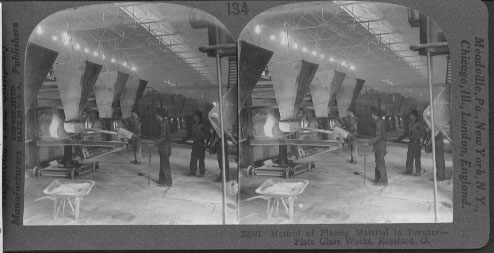
Method of Placing Material in Furnace — Plate Glass Works, Rossford, O.
Plate glass is made of pure sand, carbonate of lime, sulphate of sodam and carbon in the form of coke or coal. These materials must first be melted in pots or closed furnaces. The view here shows the method of filling the furnace from the conveyors. You will observe that the great dipperused has a long handle, so that men may stand away from the flames. The heat from the open furnace is intense. The dipper is attached to a small truck so that it can be pulled along from pail to pail. Thes pails are also suspended and fastened to a steel overhead truck directly above the furnace. As soon as the dipper is full it is pushed far back into the furnace and the material is dumped out by turning the dipper over.
After the sand and other materials are melted and changed into a pasty substance, this paste is poured on a cast-iron rolling table. The table is mounted on a truck which runs on rails so that it can be shifted from point to point in the factory. Here, on these great, smooth, sheet-iron tables, a heavy roller passes over the paste. This smoothes out the substance just as your mother rolls pie dough. These rollers weigh as mush as five tons. Just ahead of the big roller, and on either side of it, run two guards which keep the pasty glass from spreading out too widely.
The third process is that of annealing or colling the glass. The sheet of plate glass remains on the iron table where it has been rolled until it stiffens a bit. The, with two or three other sheets, it is lifted by a crane into a fire-brick kiln. Here, it rests on a floor of hot bricks. The kiln openings are built up, and the glass is cooled gradually for 3 or 4 days. The gradual cooling prevents cracking, and makes the glass tough. -
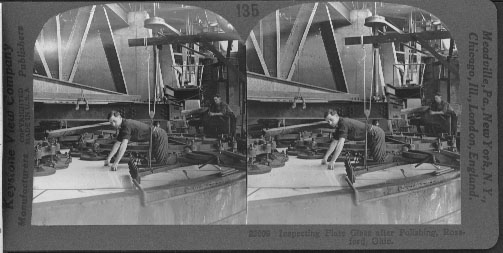
Inspecting Plate Glass after Polishing, Rossford, Ohio
After the plate glass has been rolled and properly cooled (annealed) it is taken to a cutting room where it can be shaped to a proper size.
The big plates are then moved to the polishing room. The polishing consists of three processes: grinding, smoothing and polishing. Grinding and smoothing are done almost in the same way. Rotating tables, wheels of iron such as you see are let down on the surface of the glass. Emery, fine sand, or carborundum is sprinkled on the surface. The tables of iron are let down until they fit closely against the surface of the glass and then are set in motion. The fine particles of emery, etc., cut the surface of the glass very smooth.
The next process, that of smoothing, differs from the grinding only in the fineness of the sand or emery used.
The last process is that of polishing. Revolving plates are covered with leather or some other soft material. The rubbing that the surface of the glass gets gives it a fine luster. The plates are then ready for shipping.
The United States leads every country in the world in the manufacture of glassware. The 1910 census shows that during the previous year the value of our output was $92,000,000. Our chief glass manufacturing states are New Jersey, Pennsylvania, Ohio, Indiana, and Illinois. The industry came to center in these sections because of the excellent supply of fuel. Muncie, Indiana, and other cities in that district, used their natural gas to develop their glass factories. Pennsylvania makes over one-third of the glass we produce, and the Middle Western States make another third. Belgium has the greatest plate glass factories in the world. -
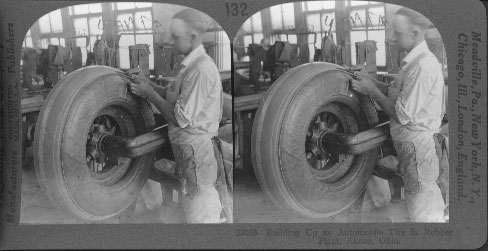
Building Up an Automobile Tire in Rubber Plant, Akron, Ohio
In the crude rubber received at the factory are sticks, dirt, bits of leaves, and beetles. These are removed by grinding the rubber in a water bath. The particles of dirt are thus washed away. The rubber is now pure enough for the first process of manufacture. The next step is to mix the rubber with chemicals. This is called compounding. In the factory here shown four or five hundred different chemicals are used to compund with rubber. Some of these are to give strength and toughness, others to give color to the rubber. It is possible to make rubber that is tougher than steel. The rubber is now ready for manufacturing purposes. What next happens to it depends on the uses to which it is to be put. For example, if it is to be made into the bandages that dentists stretch across the mouths of patients, it must be rolled very thin. This process is called sheeting. One of the greatest uses for rubber today is in the manufacture of automobile tires. You see here an automobile tire being built up. The framework of a tire is its body of fabirc or tought cloth. On an iron core, the shape of the tire, this fabric is first wound in several thicknesses. This is what the men here are doing. It is a work that demands care and skill. To become an expert workman in this department a man must have a steady hand, deft fingers, a clear eye, and good judgment. There is another way of building up tires. This is by using two crossed layers of heavy cords instead of fabric to wrap about the iron core. These cords have been filled with a rubber solution under high pressure. They are laid on the core by a machine. A tire so built up is called a Silvertown. -
![Building Up an Automobile Tire [view 2]](/stereo/graphics/22058.jpg)
Building Up an Automobile Tire in Rubber Plant, Akron, Ohio 2
The material that has been used to make up this automobile tire has passed through many machines and has been worked on by many other skilled workmen before it has reached this workman. This man is carefully trimming one of the many layers that make up this large tire. Before this tire is finished, it must be placed in a steel mould of just the right size and tread design. This mould has a metal center part which will keep the inside of the tire hollow and in shape. While in that mould the tire will be heated very hot and at the same time be subjected to great pressure. After that process the tire will go to the inspection room. There it will be thoroughly examined. Those tire that are found to be perfect will be shipped away to be sold. If any are not quite prefect, they will be marked "seconds" and sold at a lower price than the perfect ones.
You may see this very tire pass you on the road, for it is being made for one of the large, swift buses that carry passengers from one city to another.
To realize the importance of tire manufacturing you have only to remember that all automobiles must be equipped with tires, and then think of the many purposes for which automobiles are used. Perhaps you will think first of the many automobiles used for pleasure. Next remember that there is hardly a great business in the world that does not make use of automobiles. All cars used for these, and many other purposes, must have tires; therefore, tire manufacturing has become a great industry of our country. -
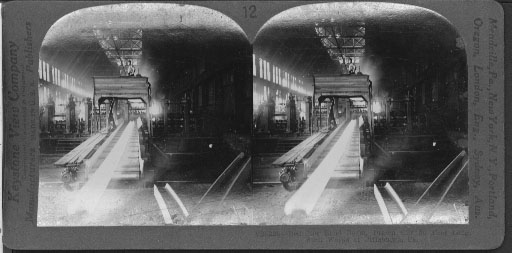
Red Hot Steel Beam, Drawn Out 90 Feet Long, Steel Works at Pittsburgh, Pa.
Pittsburgh, Pa., is the greatest steel producing city in the whole world. This picture shows a portion of the interior of one of the great steel mills. The iron is sent direct from the mine to the furnace stock pile. These are rooms in these great steel works where the iron ore and scrap iron are melted and transformed into fiery liquid. When this melted iron is drawn off it is about as thick as mild, and is called pig iron. This pig iron is the basis of all steel manufacturing. The liquid iron is then taken in huge ladles by means of electric cranes to converters or mixers. Here it is mixed with carbon of tungsten, or whatever is necessary to give the desired character to the steel. Then heavy ladles are filled with this substance and swung out over ingot moulds. The liquid steel is run into these, and freezes (way above the boiling point) into the desired shape. In the room steel rails are being made. This white, dazzling beam of metal had been rolled out to a length of about ninety feet. From this point it will be carried on rollers to a cutting platform, where it will be sawed into the proper lengths, then sent through a straightening department where the ends will be squared and the holes punched for the fishplates. It is then ready to be shipped.
The rails are loaded by a crane which is itself a huge electro-magnet. This picks up a load of steel rails as easily as a small magnet picks up a cluster of needles. -
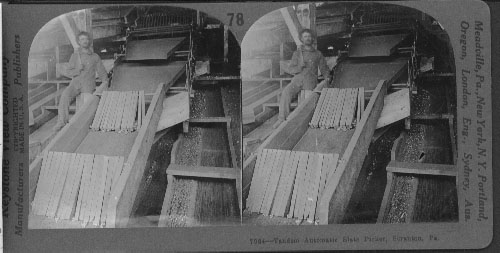
Tandem Automatic Slate Picker, Scranton, Pa.
Unless you know something of the history of coal mining, you cannot understand the value of the machine here shown. In the great breaker building the coal is first crushed. But the coal is not pure. There are minerals, especially slate, mixed with it. This must be removed before the coal is put into the cars for shipment. The labor of sorting out these pieces of slate and rock was formerly given over to boys. These were only lads of from 9 to 15 years, who sat all day long beside the small coal chute, working for a small sum of money per day. Here they sat, cramped and stooping, their little hands worn and tired, and their bodies aching.
You perhaps have heard of the term, child labor. Much has been written and said about it in the last few years. Every child should be given a chance to make the most of himself. In his youth he should be given an opportunity to learn about the things that other people do, and how they do them. Then, when he grows to manhood, he will be able to decide upon a business which he thinks he will like. The breaker boy had no chance to do this. Now laws have been passed to prevent children under a certain age, from working all day long.
Moreover, machines have been invented that make labor unnecessary in coal mining. The simple one you see here does the work of many breaker boys. As the coal slides down these chutes, the wooden jigs lift and let the lighter, fast-traveling coal pass by, but hold the heavier slate and rock. The machine is not at work, as you see it, but under each of the jigs is shown a pile of slate that had been caught. This slate is dropped into special chutes and removed from the breaker. -
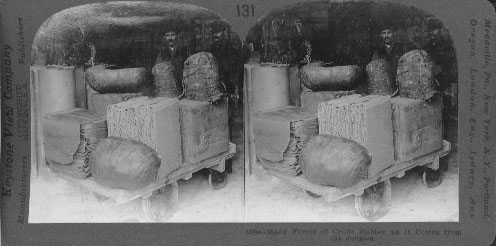
Many Forms of Crude Rubber as It Comes from the Jungle.
Forms of Crude Rubber, Akron, Ohio: This picture was taken in a great rubber goods factory in Akron, Ohio. The raw rubber you see here has come from several places in the tropics. For rubber trees grow in hot countries only, such as Brazil, Mexico, and Africa. The rubber tree is a tall, straight tree, often times 60 feet high. Its bark looks like that of the beech, and it has graceful plumes for leaves. Between the bark and the wood is a gummy fluid called latex. It is not the sap of the tree. From latex crude rubber is made. On the upper Amazon the natives go into the jungles in October to gather rubber. They tap the trees in two ways. One is by cutting the bark in a wide gash that girdles the trunk in a spiral. A trough or pail is set, and into this the latex flows from the gash. Each day the gash is extended. The other way is to tap the trees in much the same manner as sugar maples. On top of the latex so gathered a sort of cream rises. The native dips a paddle in this and holds it over a smudge of palm leaves or nuts until the latex dries. This plan he continues till he has a great ball of the size you see. The crude rubber is brought down the Amazon River in boats. Para is the chief city of the world In the export of raw rubber. In the East Indies there are many rubber plantations. There the latex is thickened by an acid, and the rubber is rolled into sheets. It is these sheets that you see on the truck. The United States imports yearly over 100,000,000 pounds of rubber. This is almost as much as Great Britain, Germany, and France combined import in the same time. Lat. 41 N.; Long. 81 W. -
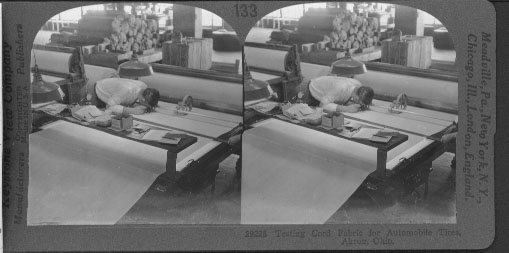
Testing Cord Fabric for Automobile Tires, Akron, Ohio
We think of automobile tires as "made of rubber." This is partly, but not wholly true. Tires are made of rubber mixed ("compounded") with other substances such as sulphur, clar, zinc oxide, carbon-black (soot from burned gas or oil), and lime, for various purposes. For rubber may be as flexible as a toy balloon or as hard as a solid tire for trucks which carry ten-ton loads.
Cotton cloth, made from long-staple cotton, is also a very important part of a tire. Heavy thread of such cotton are woven into wide sheets of cord fabric such as you see in this view. The workman in the view is inspecting the cotton fabric while it is passing over a glass table that has strong lights underneath it. He is examining the material through a magnifying glass for he must make sure it is perfect.
The cord fabric is ironed between hot rollers to make it ready for "calendering" with rubber. "Calendering" is the process that brings rubber and cotton together in one sheet. A sheet of cotton is run between heavy rollers and the rubber is pressed in between the threads of cotton so that they are like one piece of material. Many layers of such material are used in a tire.
Notice that in this view a workman is doing a very important piece of work that cannot be trusted to a machine. Machines that do wonderful things for us have been invented, but they can never take the place of a person when careful thought and judgement are needed. -
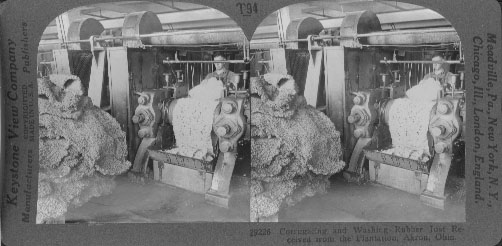
Corrugating and Washing Rubber Just Received from the Plantation, Akron, Ohio
This picture was taken in a great rubber goods factory in Akron, Ohio. The rubber is being washed by passing through great rollers over which water is flowing. Washing is the first thing done to rubber after it arrives in our factories from the tropics. The rollers also "corrugate" the rubber; that is, they press the surface into grooves and ridges. This is a sort of kneading process which breaks up particles of solid impurities in the raw rubber and thus aids materially in the washing process.
Rubber tree grow in hot countries. The tree are very tall and straight. Their bark is much like that of our beech trees. Under the bark is a gummy fluid. This fluid is called latex. From this latex, crude rubber is made. To get the latex the trees are gashed or tapped. The gummy fluid flows slowly into pails set to catch it. A pail of latex looks much like a pail of milk. Just as cream rises on milk, so rubber rises to the top of latex.
A workman builds a smoldering fire of leaves and nuts. Then he dips a paddle into the latex. Next he holds the paddle over the fire until the heat evaporates the water, leaving on his paddle a thin coating of rubber. He then dips his paddle again into the latex and again holds it over the fire. He continues doing this until his paddle has on it a thick coating of rubber. Then he cuts off the rubber and rolls it into a ball. The balls are taken to market and shipped to factories. In some countries rubber is thickened by the use of an acid.
Brazil, Ceylon, the East Indies, Africa, and Mexico all export crude rubber. Much of the rubber used in this country comes from South America. Para, Brazil, is a port noted for shipping great quantities of rubber. -
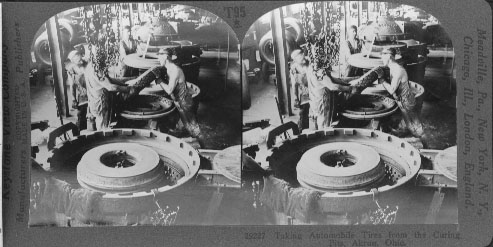
Taking Automobile Tires from the Curing Pits, Akron, Ohio
n this view the tires have just gone through the "curing" process. They are being removed from the steel forms in which they were placed for that process. "Curing" means "vulcanizing." Vulcanizing a tire means applying great heat and pressure to it. So, while in those steel forms, the tire were heated very hot and pressed very hard at the same time. The process (vulcanizing) makes the tire strong enough to stand being inflated ("blown up") by air. It also makes them strong enough to travel thousands of miles over pavements and dirt roads in all kinds of weather.
Before a method of vulcanizing rubber was discovered, our rubber goods were few and far from satisfactory. A rubber rain coat in winter became so stiff that it would stand alone. In summer the same coat became soft and stickey and stretched out of shape. Charles Goodyear, and American living in Connecticut, spent nine years in hard work and poverty trying to find a way to treat rubber so that it would not crack in winter or melt in summer. One day he threw a lump of rubber mixed with sulphur into the fire. Great was his surprise and joy to find that the fire did what he had been trying to do; it toughened the mass. Over five more years he worked to perfect his process. Without Mr. Goodyear's wonderful discovery many articles now made of vulcanized rubber would be unknown. Certainly automobile tires such as we see today would be impossible. The process of hardening rubber was called "vulcanizing" in honor of Vulcan, the Roman god of fire. -
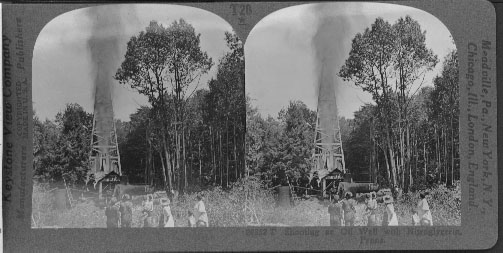
Shooting an Oil Well with Nitroglycerin, Penna.
The word petroleum means "rock oil," or oil that comes from the ground. Far down in the earth, sometimes as far as 4,000 feert, petroleum is stored in sands which lie between layers of rock through which the oil cannot escape. We need that oil because from it are made gasoline, lubricating oils, and other products. This well has been drilled, and the driller found, by examining the dirt brought to the surface by his machine, that oil was near. The he lowered a can of nitroglycerin into the well. You know that nitroglycerin is a very powerful explosive. In the top of the can was a torpedo. A weight called a go-devil was next dropped upon the can. The torpedo exploded and ignited the nitroglycerin. A terrific explosion followed. You see the result. The oil was forced up the well and shot high into the air! That derrick is 72 feet high and the streem or oil is much higher.
This well should now yield oil for some time. If the pipe becomes clogged with paraffin, it may be torpedoed again. If such and explosion does not start a flow of oil, the dirller must either drill deeper or drill in another place.
Most petroleum is dark green in color. Some of it is thick as syrup, some is like kerosene. All crude oil must be refined before it becomes gasoline. From the storage tanks near the weeksm it is carried away in tank cars or is driven by pumps through pipes to refineries. These pipe lines are laid under rivers, through mountains, under out very feetm for hundreds of miles. In the refineries, pertoleum is heated and different products are obtained, of which the most important and valuable is gasoline. -
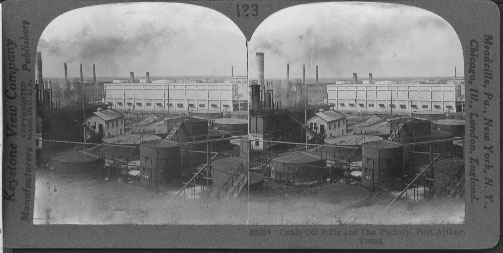
Crude Oil Stills and Can Factory, Port Arthur, Texas
Port Arthur is located on Lake Sabine, Texas, near the Gulf of Mexico. It is one of the great oil exporting ports in our country. Oil pipes connect it with the large oil-producing fields. One of these pipes is shown plainly here.
Formerly the usual method of conveying oil was in oil cars. These are large boiler-like tanks fastened on freight car trucks. This method has been largely displaced now by pipe lines. The oil fields of Pennsylvania are connected by pipe lines with New York, Philadelphia, Pittsburgh, Baltimore, and Cleveland. These have been extended to the oil fileds of Indiana and Oklahome. Now Chicago and other cities on the Great Lakes, certain cities on the eastern seasboard, and cities on the Gulf are interlinked by pipe lines. Pumping plants are located at distance apart along the line so that the flow of oil in the pipes is constantly kept up. The oil so carries from the wells is in its crude form. The large tanks that you see here are receiving stations. The oil may be taken from the tanks and refined here, ot it may be put on board oil steamers in its crude form. The large building in the background is and oil canning factory. This building receives sheet tin and makes it into cans. These cans are filled with oil, sealed, and labeled.
We are likely to forget that for the entire twnty-four hours of the day this flow of oil continues in the pipe lines. It takes thousands and thousands of wells to produce so much pertoleum. The digging or these wells keeps and army of workmen busy.
Originally petroleum was used chiefly for lighting purposes. Now it furnishes power for ships, locomotives, automobiles, and factories. -
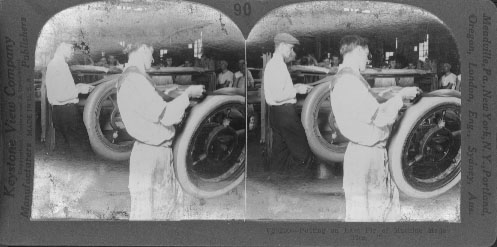
Putting on Last Ply of Machine Made Tire
In the crude rubber received at the factory are sticks, dirt, bits or leaves, and the beetles. These are removed by grinding the rubber in a water bath. The particles of dirt are thus washed away. The rubber is now pure enough for the first process of manufacture.
The next step is to mix the rubber with chemicals. This is called compounding. In the factory her shown four or five hundred different chemicals are used to compound with rubber. Some of these are to give strength and toughness, others to give color to the rubber. It is possible to make rubber that is tougher than steel. The rubber is now ready for manufacturing purposes. What next happens to it depends on the uses to which it is to be put. For example, if it is to be made into bandages that dentists stretch across the mouths of patients, it must be rolled very thin. This process is called sheeting.
One of the greatest uses for rubber today is in the manufacture of automobile tires. You see here an automobile tire being built up. The framework of a tire is its body of fabric or tough cloth. On an iron core, the shape of the tire, this fabric is first wound in several thicknesses. It is a work that demands care and skill. To become an expert workman in this department a man must have a steady hand, deft fingers, a clear eye, and good judgment.
There is another way of building up tires. This is by using two crossed layers of heavy cords instead of fabric to wrap about the iron core. These cords have been filled with a rubber solution under high pressure. They are laid on the core by a machine. A tire so built up is called a Cord. Many tire are thus built at Akron, Ohio. -
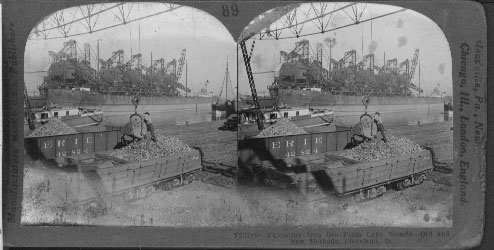
Unloading Iron Ore From Lake Vessels-Old and New Methods, Cleveland, O.
Cleveland is the largest city in the state of Ohio, and it situated on the south shore of Lake Erie at the mouth of the Cuyahoga River. It had excellent connection by water with Superior iron regions. It has a lake frontage of about fourteen miles, protected for five and three-quarter miles by a breakwater constructed by the Federal Government. The harbor has unexcelled facilities for handling iron ore. That lake steamer over yonder and the nearer vessel at our left have come down from the western end of Lake Superior, laden with ore for great steel mills at Youngstown, Pittsburg, or Wheeling.
A few years ago the unloading system which we see in operation directly before us was considered splendidly effective. That suspended bucket has been lowered into the vessel's hold and there filled, then drawn along an overhead trolley beam for dumping into the car.
Today the "clam" unloaders are more commonly used. We can see this apparatus looming in the air above that farther pier. By this newer method, five to ten tons of ore can be lifted in one load, and the work can be done much more quickly than by the "pocket" method. -
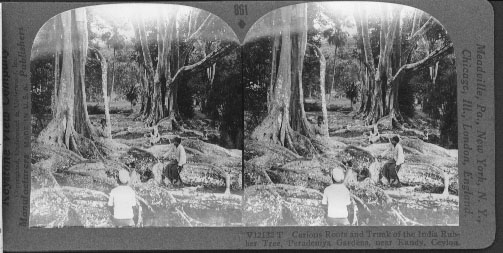
India Rubber Tree. Peradeniya Gardens, near Kandy, CeylonYou are within the wonderful 150-acre enclosure of the Royal Botnaic Gardens, four miles from Kanyd, the old Ceylonese capital. The gardens are passed on the way up from the port of Columbo, seventy miles away on the west coast.
These gigantic trees form a stately avenue near the main entrance to the park. In some parts of India rubber trees reach almost incredible dimensions - trunks 100 feet high and 75 feet in circumference, with a roof of foliage covering an area of 1600 square feet; these tree you see now are not quite so huge, for they belong to a different species, but they are big enough and queer enough to be a conspicuous feature even in this garden of tropical wonders. Notice the extraordinary shapes into which the roots have squirmed and writhed, as they reached out over the surface or the ground.
It is a near relative to these tree from whose milky juice "caoutchouc," our more familiar rubber, is procured. The Chinese have for a good many centuries known how to treat the juice to get a peculiar elastic gum for various uses, but the possibilities of the stuff were first suggested in Europe by a French traveler in South America in 1735. The enormous development of rubber manufactures in the nineteenth century led India as well as other tropical countries to contribute raw materials; large quantities are exported annually from Singapore.
These are native Singhalese whom you see sitting on the serpent-like coils of the tree roots. The costume, which includes a sort of scanty petticoat, is such as the average Columbo citizen is accustomed to wear. -

A Comprehensive View of Smaller Unloaders at Work on the Ore Docks, Conneaut, Ohio.
VIEW OF ORE UNLOADERS AT WORK, CONNEAUT, OHIO: On the right is a lake steamer laden with ore from the Lake Superior district. It is at the docks alongside an unloader. This unloader is only a huge steel framework with a number of tracks extending on one side over the dock, and on the other side over the switches. The trucks on these overhead tracks are equipped with buckets which dip the ore out of the hold of the vessel. The bucket is pulled by an engine, up to the truck to which it hooks. This releases the truck, which travels to the other end of its tracks, and there the bucket is lowered and emptied.
The view shows one car on the right being loaded. The truck on the left is dumping its bucket of ore into the freight car. Four series of cars can be loaded here at the same time. The hoist, or steel framework, is 60 feet high and 180 feet long. The bucket is of the type called calm shell. The steel cars into which the ore is dumped are shaped inside like hoppers. That is, their bottoms are sloped. When these cars reach the steel mills, the hopper is opened at the bottom and the ore is dropped into bins below the tracks. Each car can carry 50 tons of ore, and on the return journey will carry 38 tons of coal.
You will observe lying on blocks of wood on the ground, two pairs of steel cables. Each of these cables is slowly moving. When it is necessary to move the car, or the series of cars, to shift them under the buckets, a chain is attached from the cable to the car. When the car had been brought into the proper position the chain is unhooked. -
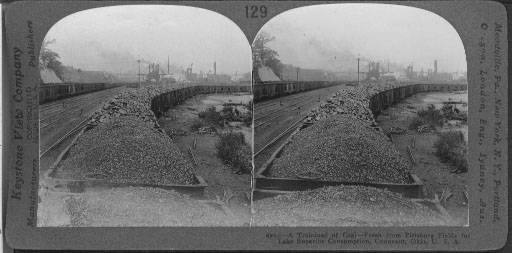
A Trainload of Coal from Pittsburgh Fields for Lake Superior Consumption, Conneaut, Ohio
There is nothing unusual about this scene. On almost any of the great railways in the eastern and middle western sections of our country such trainloads of coal as this can be seen any day. But there is a particular interest connected with this and similar trainloads of coal running from the Pittsburgh district to the Great Lakes. Our greatest iron ore deposit lies at the western end of Lake Superior. In this district, however, there are no coal fields. One of the two things must be done. Either coal must be taken to the ore fields, or the iron must be brought to the coal fields. Coal is needed to heat the iron so that it can be made into steel. When the Lake Superior iron district was first worked, all the ore was carried by huge lake boats to the coal district. But by this method, theses boats had to return empty. This was a great waste. Now the shipping is carried forward both ways. Iron and steel refineries have been built in the Superior District. The vessels that bring iron ore east, carry back heavy cargos of coal to be used in the Superior iron district. This trainload of coal that you see will be put on board one of these ships and unloaded at Duluth or Superior, not far distant from the iron ore area. This make the ports along the southern shore of Lake Erie the natural exchange place of coal and iron. Among these important ports are Buffalo, Erie, Cleveland, Toledo, Ashtabula, Lorain, and Conneaut, the city here shown. Locate each of these cities on your map. Trace a shipment of coal from Conneaut to Duluth. Through what waters does it pass? Lat. 42 N.; Long. 81 W. -
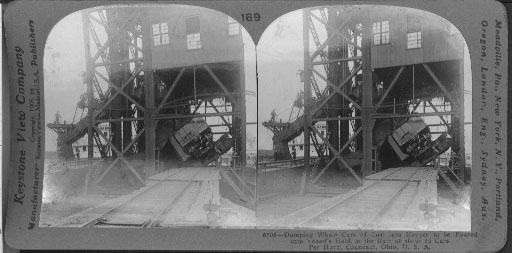
Dumping Whole Cars of Coal into a Hopper to be Poured into Vessel's Hold, Conneaut, Ohio.
This picture shows you how coal is quickly and easily transferred from the railroad cars to the ship's hold. The car which you see on the dock is held by great clamps to the platform. Then the platform, with the car fastened to it, is raised and tipped so that all the coal pours out into a hopper. Other machinery then moves the coal from the hopper to the ship's hold.
The dock in the view is at Conneaut, Ohio. Conneaut is one of the ports along the southern shore of Lake Erie, which has become and exchange place for coal and iron. Our greatest iron ore deposit lies at the western end of Lake Superior. In that district, however, there are no coal fields, and coal must be had to heat the iron ore, and to furnish carbon to mix with it, so that the iron can be made into steel. One of two things must be done. Either the coal must be taken to the iron fields, or the iron must be brought to the coal fields. At first, the iron was taken to the coal fields, and empty boats returned for more ore. Now steel refineries have been built in the Superior district similar to those near the coal fields in the east, so that today the shipping is carried on both ways. The vessels that carry iron east, carry back coal to be used in the Superior district. The coal being loaded at Conneaut will be taken to Duluth or Superior not far from the iron ore area.
Buffalo, Cleveland, Toledo, Ashtabula and Lorain are other ports which have become exchange places for coal and iron. Locate these posts. -
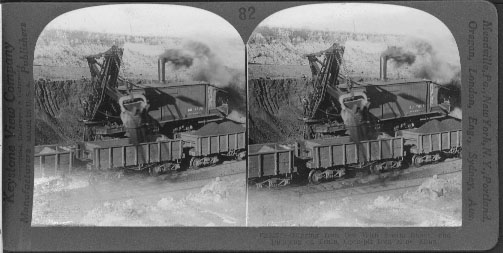
Digging Iron Ore With Steam Shovel and Dumping on Train, Open-pit Iron Mine, Minn.
OPEN-PIT IRON MINE, MINNESOTA: Iron is the most useful and most abundant of all metals. It is seldom found in its perfect natural state. It is usually combined with oxygen and other elements and found as a constituent of rocks.
Because of its iron ore, Minnesota holds an important place among the mining states of the Union. In some places the mineral is found here in almost a pure state. This picture is taken near Hibbing, in the northern part of Minnesota. It is in what is called the Lake Superior mining region, probably the largest iron producing section of the world.
Ore was first taken from it in 1884. In less than fifty years the total output of the Lake Superior mines was 192,008,000 long tons. A single mine in Minnesota has produced 1,681,000 long tons of ore in a year. The deposit is near the surface, so that mining can be carried on here on a very large scale. Sometimes the ore is dug out by steam shovels and loaded directly on the cars, as shown in this picture. A single one of these steam shovels can load two hundred cars a day, doing the work which formerly required two hundred men. Most of the ore is shipped by rail to ports on Lake Superior and Lake Michigan, great quantities going to the manufacturing centers of Pennsylvania. -
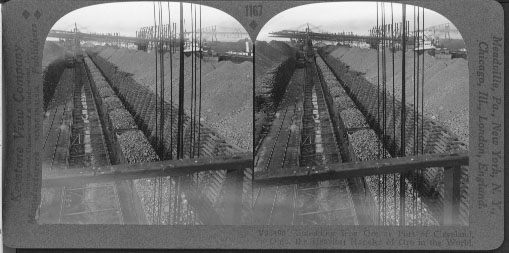
Unloading Iron Ore at Port of Cleveland, Ohio, the Heaviest handler of Ore in the World.
Iron Ore at the Port of Cleveland: Going westward from downtown Cleveland, we pass over the famous High Level Bridge and Bulkley Boulevard. In going through this part of the city sights such as this are common for many of Cleveland's ore docks and lumber yards are almost hidden on the flat land bordering the Cuyahoga River which empties into Lake Erie. A visit to Cleveland's waterfront is a fascinating adventure. Here we are looking north toward the lake. The steamers we see in the distance have come from the iron county in the vicinity of the western end of Lake Superior, where are located some of the richest iron mines in the world. To the port of Cleveland is brought over 4,000,000 tons of iron ore every year. Those long lines of piles on either side are some of this ore. Those gigantic arms in the distance that reach out over the railway tracks are part of the huge unloading machinery by which means the ore in all these piles has been taken out of the holds of the ships and dumped here. Notice the coal in the long line of freight cars. This coal is to go back to the iron county in the steamer that brought over the ore. These cars will be sent to a coal dock. As soon as the ore boat is unloaded, it will go to the coal dock and be loaded with coal. In turn the ore will be loaded into these cars after they are emptied and thus will reach the iron-manufacturing center where it will be transformed into steel. The steel eventually may reach Africa as a steel rail for a railway track, or Asia as bridge material that will span a Himalayan mountain gorge. -
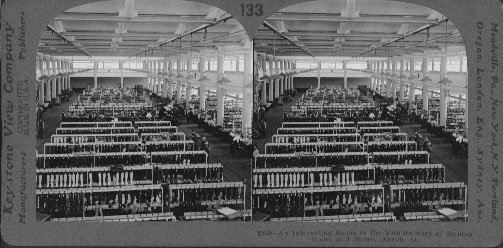
Making Rubber Boots and Shoes, Akron, Ohio.
In rainy weather nothing is so much needed as a raincoat and a pair of rubber boots or overshoes. In the rubber factory you see here many kinds of rubber goods are made. Raincoats are made by the thousands. Instead of cutting each coat separately, 40 or 50 pieces of fabric are cut at one time by machinery. Each coat is so cut follows the pattern to a nicety.
Then there is the boot and shoe department. This firm makes about 25,000 pairs of boots and 25,000 pairs of "rubbers" every working day. This means that here 25,000 people could be fitted out dry shod every single day. The section shown here is the boot and "rubber" department.
Boots and "rubbers" are builty up on a boot or shoe form or last. Pieces of fabric and rubber cut to the proper shape, are laid on the form. The boot or "rubber" is then vulcanized. That is, it is heated, and the rubber particles are welded together by compressed air. This makes the boot tougher than it could possibly if built up and merely dried out in ovens.
Men working here out to be able to keep healthy on account of the good lighting and ventilation. This is a good illustration of our large modern factories. This concern employers in its various departments between 18,000 and 20,000 people. Such factories make a city famous for their product. -
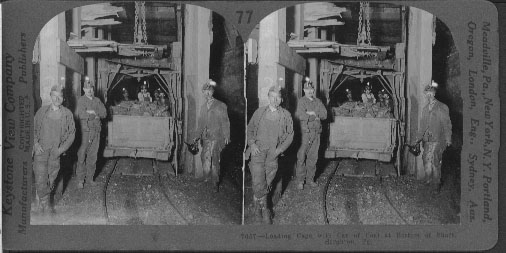
Loading Cage with Car of Coal at Bottom of Shaft, Scranton, Pa.
Here you are at the bottom of an anthracite, or hard coal mine. This is the lower end of the large shaft which leads to the surface of the earth perhaps 1,500 feet above. A carload of coal is on the elevator or cage ready to be lifted to the top of the dump into the breaker. The cage and the shaft are the center of a mine of this kind. To it lead the many switches from acres of underground rooms. It is necessary that this shaft be constructed of strong materials. For not only must all the coal be brought to the surface through it, but it is the only exit of the hundreds of miners.
You can see for yourself that the shaft and cage here shown are strongly made. You will observe the large timbers, the heavy framework of the cage, and the big safety chain above. The weight on the cage you can figure for yourself. The car weighs one ton and the coal two tons. The cage weights 1 1/2 toms and the 1500 feet of wire rope, which lifts it, another 1 1/2 tons. How much is this in all? You will be interested to know that the rope is made of strands of woven steel wire, 19 wires to the strand. It is 1 1/8 inches in diameter and can lift a weight of 60 tons. Some of the cages used in these mines have two decks, one about the other. By this means, two cars of coal can be lifted at a time.
Some of the Pennsylvania shafts are sunk 3,000 feet beneath the surface of the earth. This means that some of the coal is actually mined below sea level. In many of these deep mines it is necessary to have extensive pumping equipment to remove the inflow of water. Pennsylvania mines, however, are shallow as compared with most of those in Europe. Some of the European mines are over a mile in depth. -
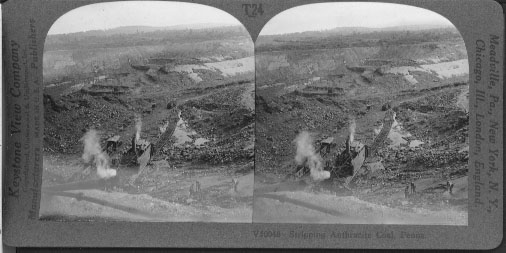
Stripping Anthracite Coal, Penna.
When a vein of coal lies near the surface of the earth it is mined in the way shown in this picture. All the dirt on top of the coal is removed by big steam shovels, one of which you can see at work. The dirt so removed is called strippings. The machines which do this work weigh almost fifty tons and remove strips of earth about twenty-five feet wide and ten feet deep. The stripping is hauled away in small cars. Notice that more earth had been removed in the center of the view. There the vein of coal is uncovered and can be taken out from the top. All that great hill of earth on the left must be cleared away, but great as the work is, it is cheaper to do it than it is to sink shafts into the ground and do the mining underground.
By the stripping method all the coal can be mined, but in mining from shafts supports of coal must be left at certain distances apart to hold up the ceiling. Mining from shafts, sunk from the surface of the earth downward, or into the side of a hill, is the more common way of coal mining because most coal is not near enough the surface to be reached by the stripping method.
Which method of mining do you think the miners prefer?
Where are the anthracite coal mines of this country? -
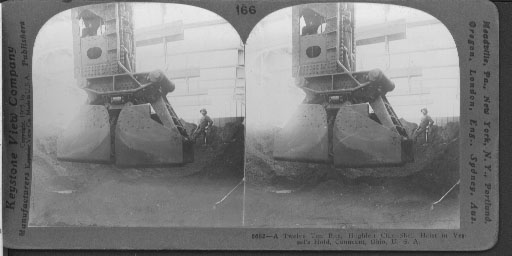
A Twelve Ton Bite, Hughlette [sic] Clam-Shell Hoist…, Conneaut.
Twelve-Ton Bite: The huge bucket has descended from its position in view 6681 through the hatchway into the hold of the vessel. The operator moved a lever, the piston-rod seen in 6681 ascended into its jacket, the great jaws closed upon 12 tons of ore and the length of the bucket from right to left was reduced from 22 feet to 9 feet. The machine to which the bucket is attached is now in the position of the second machine shown in view 6680. In less than thirty seconds the operator, by moving his levers, will cause the load to rise above the deck, the machine to back into the position of the first one seen in view 6680, and the load to drop into the transfer car. This great machine delivers its huge loads to the stock piles at the rate of one load per minute. The average load is 10 tons.
This is the hold of a modern ore boat capable of carrying 12,000 tons of ore. Only four such boats have yet been built. They are 650 feet long and 52 feet wide. The hatchways are twelve feet apart. The deck is supported by steel arches from the side of the boat. This makes the hold of the vessel one great room unobstructed by partitions or pillars of and kind. This room is 400 feet long, 50 feet wide, and 32 feet high. The numerous hatchways enable the unloaders to do the work with little or no hand labor in the hold. The Hulett bucket may be turned by its operator in and direction and moved back and forth along the hatchway at his will. -
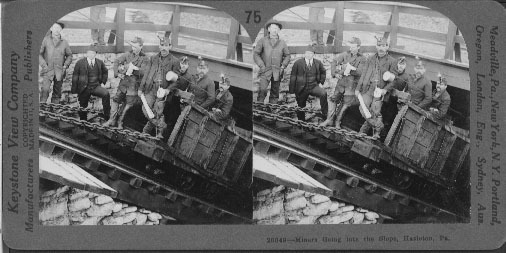
Miners Going into the Slope, Hazleton, Pa.:
You see here a crowd of miners on a car ready to be lowered into a Pennsylvania coal mine. Inside the shaft, running directly down into the earth, there is a tunnel, or slope, as it is called, leading into the mine. On cats such as the one here shown coal is brought to the surface from far back in the mine. A stationary engine furnishes the power to drag the cars up the steep incline.
The scene is rich in suggesting the life of coal miners. On top of the caps of the men are lamps, some of which are already lighted. Oil is burned in these little tin lamps. One of the miners has on rubber boots, because there may be water in certain parts of the mine. Most of the men seen here are foreigners. The overseer or "boss" of the mine is easy to find.
If you were to go with these miners you would likely find that the slope was built through a vein of coal. Sometimes, however, the vein is tapped by cutting through dirt and rock. At any rate, when the slope comes to the coal vein, it winds about in the heart of the vein. Leading off from either side of it are long tunnels in which switches have been built so that the cars can be run off to the various rooms and there loaded.
The life of these miners is not east. They are well paid, the amount they receive annually depending on the amount of coal they mine. But it is lonely work. All day long, with drill, pick, and shovel, they labor steadily. Sometimes an accident happens. Gases form in some of the mines, and these are set on fire by the lights on the miners' caps. An explosion occurs. Sometimes many miners are cut off far below ground. Rescue parties may work for days in an attempt to save their lives. -
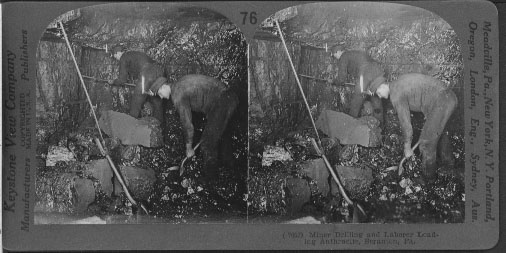
Miner Drilling and Laborer Loading Anthracite, Scranton, Pa.
Here you see a miner and his helper working in a coal mine. The miner contracts with the company to mine the coal for so much per car or per ton. He furnishes his own tools, pays for the powder with which to blast the coal loose, and hires a helper to assist him at so much a day or so much per ton.
The miner in the background is drilling a hole in the solid layers of anthracite, making ready to put in a blast of powder. The helper is busy shoveling the loose coal into a car which will carry it to the elevator. From there it will be taken to the surface where there is a coal breaker. You will observe that each man has a tin lamp fastened to the front of his cap. What looks like candles sticking up from these lamps are the sheets of flame.
This scene was taken with a flashlight, so the mine appears to be very well lighted. As a matter of fact, it is pitch dark in here. The lamps from the miners' cap make just enough light to cast queer-looking shadows in all the corners. How would you like this kind of work, far below ground in the dark?
Anthracite is the coal we call hard coal. The soft coal is called bituminous coal. The anthracite district of the United States is a small area, and Scranton is in the very heart of it. Soft coal is found in many states. Pennsylvania leads in the production of both kinds. In the United States, but little anthracite is found outside of Pennsylvania. West Virginia, Illinois, Ohio, Kentucky, Indiana, and Alabama are our most important producers of soft coal. The value of bituminous coal in the United States in 1915 was over $500,000,000. The value of the anthracite was $185,000,000. 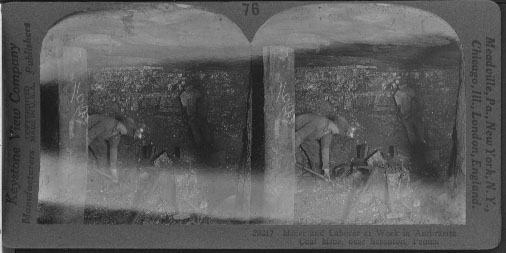
Miner and Laborer at Work in Anthracite Coal Mine, Scranton, Pa.
No accompanying text available.
3D version not available.-
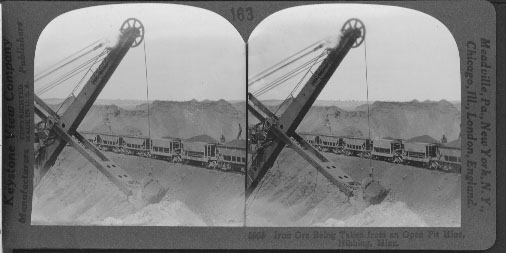
Iron Ore Being Taken from an Open Pit Mine, Hibbing, Minn.
This steam shovel is scooping up iron ore in an open-put mine in the Mesaba Range in Minnesota. This is the most valuable iron region known in the world. Most iron is hard rock and must be blasted. It must also be mined underground. But in this unusual mountain range the iron ore is so near the surface and so soft that it can be mined with steam shovels such as you see in this picture. This shovel is cutting a trench several yards wide. It is loading the ore it removes into those cars near by. This shovel can load one of those cars in about three minutes. Each year the Mesaba Range mines furnish one-third of the world's supply of iron. The Mesaba, The Vermilion, and Cuyuna Ranges, all in northern Minnesota, enable the United States to lead the world in iron and steel industries.
At one time all the iron ore from this district was shipped to the eastern coal fields. This was economical because it takes two tons of coal to smelt every ton of ore. However, instead of allowing the ore boats to return empty they were finally used to bring back coal so that some of the smelting could be done in the iron districts.
Iron and steel, which is a form of iron, are so necessary to us today that if all iron suddenly disappeared we would have to live almost as savages do. Our tools, machinery, screws, nails, ships, engines, automobiles, car tracks, frame work for large buildings, stoves, and many other things are made wholly or partly of this important and valuable metal. -
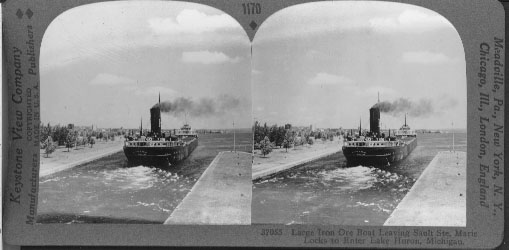
Large Iron Ore Boat Leaving Sault Ste. Marie Locks to Enter Lake Huron, Michigan
THE LOCKS AT SAULT STE. MARIE, MICHIGAN: We hear a great deal of the Suez Canal and of the Panama Canal, but there is a canal in the United States that handles more traffic than either. The Great Lakes in the United States furnish the most remarkable inland waterway in the world. To make this waterway navigable all the way from Duluth, Minnesota, to Buffalo, New York, it was necessary to do several things. The river connecting Lakes Erie and Huron had to be deepened and the connection between Lake Huron and Superior had to be negotiated in some manner.
In order to get boats through from Lake Superior to Lake Huron a canal had to be built around the rapids of St. Mary's Falls Ship Canal, popularly called the "Soo Canal." More tonnage passes through it yearly than through any canal in the world. This canal is 1 1/2 miles long and deep enough to carry the largest lake boats. One of the locks alone is 1,350 feet long and will carry boats that draw 24 1/2 feet of water.
Boats laden with iron ore from Superior, grain from Duluth, or coal from the Pittsburgh district all pass through this waterway. The odd looking freighter entering Lake Huron is well adapted to carrying ore or coal on the lakes. It is like a huge iron box with a flat bottom. There is a little house at each end. In one the crew lives. In the other is machinery. Some of these boats carry 10,000 tons of freight at one time. In 1939 more than 69,850,000 tons of freight went through the canal. The value of this tonnage was estimated to be about $1,012,829,000. -
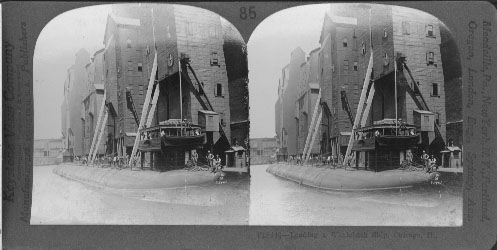
Loading a Whaleback Ship, Chicago, Ill.
Chicago is situated in the center of the Great Central Plains, one of the most fertile and prosperous regions of the world. It is a wonderful grain producing district and has been called the "Bread Basket of the World." Most of the grain raised here and in the agricultural districts of the West is shipped to Chicago for distribution.
In this picture a cargo of grain is being loaded into a whaleback ship at one of the great grain elevators, with a comined capacity of thirty-two million bushels. Inside the tall building which we see in this view are enormous grain bins twelve feet square and eighty feet deep. The grain is drawn up into these bins by means of a series of buckets fastened to an endless belt which extends from the top of the bin to the loaded car or vessel. From these bins the grain passes through a hopper, which measures accurately, and is then sent in a continuous stream through great spouts into the back of the "Whaleback," to be transported to some port in the Great Lakes. The "Whaleback" is an extraordinary form of vessel designed especially for Lake freighters. These low, flat vessels use steam only, are without masts, and their peculiar shape, resembling the back of a whale, makes them safe in heavy storms which come up more suddenly in the Great Lakes than on the ocean. A heavy sea can wash over them without doing any damage.
The value of the grain in one of these elevators varies with the outlook for a good or poor crop - in the near future. Speculators also raise and lower the price, as is done with oil. -
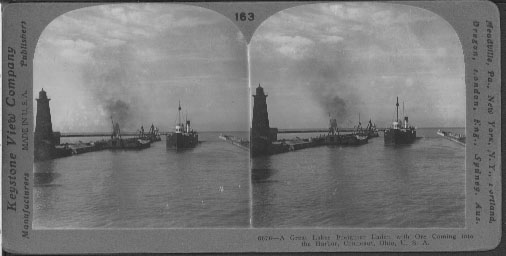
A Great Lakes Freighter Coming Into Harbor, Conneaut, Ohio, U.S.A.
The smaller ore boats carry about 3,000 tons of ore while the largest carry more than 12,000 tons. Ths one shown in this view is a medium-sized boat and may be carrying 5,000 tons. The view is to the north across Lake Erie. On the west side of the harbor are two lighthouses. These are range lights. They are placed on the west side of all Lake Erie harbors. At night, the boat must get in line or in range with these two lights while yet several miles from shore. Then by keeping in range with then it is sure to make the harbor.
The report of the collector of the U.S. Customs shows that 1362 vessels entered Conneaut Harbor during 1940. The receipts were 4,038,755 tons of iron ore; 52,104 tons of pier stone; and 458 tons of other freight. This was more iron ore than received at any other port on the Great Lakes. The iron ore receipts for 1950 will probably be 5,250,000 tons, but Ashtabula, Ohio will receive somewhat more than Conneaut this season. The shipments from Conneaut Harbor for 1940 amounted to but 413,320 tons, 98 per cent of which was coal, and one-third of this coal was used as fuel on the boats.
The receipts and shipments mentioned concerned domestic commerce only. The imports for 1940 were valued at $53,216. They were mainly lumber. The exports were valued at $3,774,562, of which about 15 percent was bituminous coal and nearly 85 percent steel rails and other forms of manufactured steel. The foreign commerce was wholly with Canada. -
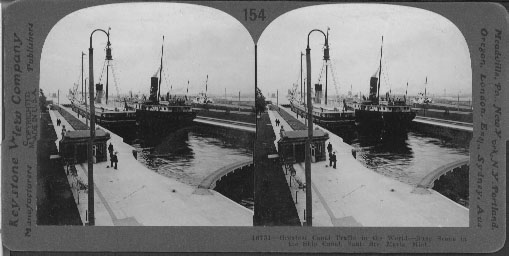
Large Iron Ore Boat Coming into Sabin Locks, Sault Ste. Marie, Mich.
The Great Lakes furnish the most remarkable inland waterway in the world. To make this waterway navigable all the way from Duluth, Minnesota, to Buffalo, New York, our country had done several things. The lake and rivers connecting Lakes Erie and Huron have been deepened. A canal has been built around the rapids in the St. Mary's River, which is between Lake Huron and Superior. This is known as the "Soo Canal." Lake Superior is twenty-three feet higher than Lake Huron, so the canal is provided with locks which lift the boats going west and lower those traveling east. This "Soo" canal handles more freight than any other canal in the world.
The odd looking "freighter" entering the locks is very well adapted to carrying ore or coal on the lakes. It is like a huge iron box with a flat bottom. There is a little house at each end. In one the crew lives. In the other is machinery. Some of these boats carry 10,000 tons of freight at one time.
What do they all carry? Many carry iron ore, which comes from the mines near Hibbing, to eastern ports. At Duluth and Superior the world's greatest elevators (store houses) are full of wheat awaiting shipment. Copper and lumber also make up many cargoes. The westward bound boats carry a greater variety of freight. Coal fills the most boats. (Why?) Others are loaded with dry goods, clothing, groceries, automoblies, machinery, and many smaller manufactured articles. -
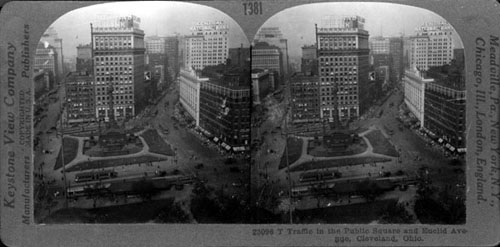
Traffic in Public Square and Euclid Avenue, Cleveland, Ohio
We are in the very heart of Cleveland, county seat of Cuyahoga County, and fifth city in size in the United State. From the Public Square before us, with its great Soldiers' and Sailors' Monument and statue of General Cleveland (sic), radiate the principal streets of the east side of the city, and to this Square converge the principal trolley lines. Here begins the famous Euclid Avenue, for some distance occupied by business houses, but farther out a handsome residential district, shaded by elms and maples and lined with palatial private homes surrounded by spacious grounds and gardens. The skyline of the business section of the city is broken by huge skyscrapers and by large department stores. The City Hall, Post Office, Chamber of Commerce and other public buildings, as well as fine hotels which provide every convenience an comfort are nearby. in the residential sections, remote from the roar of traffic, are to be found luxurious apartment houses, handsome churches, numerous parks an gardens and broads, well-lighted, attractive drives. The situation of Cleveland, on the southern shore of Lake Erie, near the iron producing regions of the Great Lakes on the one hand and the oil and coal of Pennsylvania on the other , ahas greatly favored the industrial and commercial development of the city. Some of the leading trunk lines of the railway system on the country pass through Cleveland, and there is an immense lake traffic. Many of the ore docks and lumber yards are almost hidden on the flat land bordering the Cuyahoga river, which empties into the lake. -
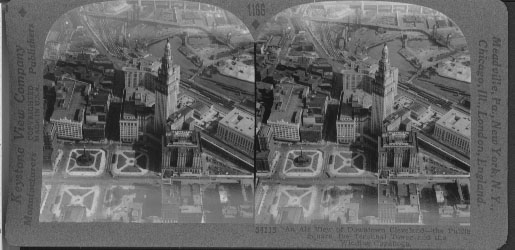
An Air View of Downtown Cleveland — the Public Square, the Terminal Tower and the Winding Cuyahoga
The Heart of Downtown Cleveland From The Air: The situation of Cleveland on the shore of Lake Erie, near the iron producing regions of the Great Lakes on the one hand and the oil and coal of Pennsylvania on the other, has greatly favored its industrial and commercial development. From an airplane fourteen hundred feet in the air we are looking down over the very heart of Cleveland. The park-like area in the immediate foreground is its famous Public Square which was laid out by Moses Cleveland (sic) in 1796. The wide street running through the center is Superior Avenue. The dominating structure in the scene beneath us is the tower of the Union Passenger Terminal, one of the finest railway terminals in the world. Here has been developed the nucleus of a small city in an area of about thirty-give acres. The Terminal Building group is a one hundred million dollar development and consists of a bank, a hotel. , a department store, a Medical Arts Building, and a Builders Exchange Building in addition to the Terminal Tower Building. The Tower soars to a height of 708 feet above e the concourse level. In the background is the Cuyahoga River that flows in winding, crooked S's through Cleveland's downtown industrial area before it finds its outlet in Lake Erie. Along the river are situated many of Cleveland's large iron and steel plants as well as many of the docks that accommodate a great share of its lake shipping. Owning to the variation in level of different parts of Cleveland there are several elevated viaducts and many bridges, nearly all municipally owned, that span the Cuyahoga River and unite the different sections of the city. Some of these are seen in the background. -
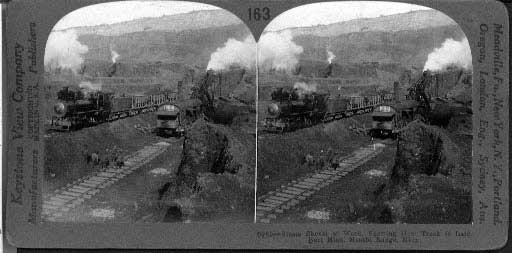
Steam Shovel at Work, Showing How Track is Laid, Burt Mine, Mesabi Range, Minn.
In many was the Mesabi Range is the most wonderful of any mountains in the world. The range is low, most of the mountains being mere hills. But a large part of these hills is made up of free iron ore. The ore, as you see, is scooped up in some places by steam shovels just as gravel is removed from pits.
In most places it is necessary to remove an overlay of several feet of clay. You can see this clay banked in the extreme background. Once the layers of ore are reached, they are removed on different levels. The steam shovel working in the foreground is cutting a trench several yards wide. The ore that it removes is dumped into ore cars that stand on tracks near by. Directly behind the steam shovel another track is being laid. As soon as the ore has been shoveled the full length of the track that is now being made, the ore cars will run on the track in the foreground.
The present Mesabi Range is the foot of an old mountain ridge worn down by glaciers. It is by far the most important iron-ore producing section in the whole world. Annually it produces almost 30,000,000 tons of ore, one-third of the supply of the world. This range, taken with Vermilion and the Cuyuna ranges, all in northern Minnesota, make the United States the leading nation of the world in the iron and steel industry. In recent years, iron smelters have sprung up in this section of Minnesota. The coal and coke needed for fuel are brought by the ore ships on their return trip from the east. But, generally speaking, it is far more profitable to take the iron ore to the coal district than to bring the coal to the iron district.



